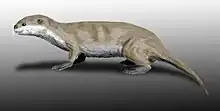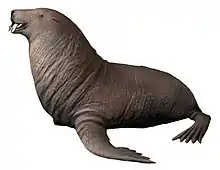| Hadrokirus Temporal range: Late Miocene ~ | |
|---|---|
| Scientific classification | |
| Domain: | Eukaryota |
| Kingdom: | Animalia |
| Phylum: | Chordata |
| Class: | Mammalia |
| Order: | Carnivora |
| Clade: | Pinnipedia |
| Family: | Phocidae |
| Subfamily: | Monachinae |
| Genus: | †Hadrokirus |
| Type species | |
| †Hadrokirus martini Amson & De Muizon 2013 | |
| Other species | |
| |
Hadrokirus is an extinct genus of true seal (Phocidae) that lived on the coast of Peru and North Carolina about 6 million years ago. The type species, H. martini, was found in the Pisco Formation, together with other marine animals such as crustaceans, sharks, coastal birds, whales and aquatic sloths. The distinguishing feature of the seal was its teeth: they were extremely robust, hence the name (hadros, "stout" in Greek; kiru, tooth in Quechua). It is assumed that Hadrokirus martini was durophagous; its diet probably comprised crustaceans, small bivalves and other shelled animals, similar to that of the living sea otter. The living seals most closely related to Hadrokirus are the Antarctic seals.[1]
References
- ↑ Amson & De Muizon, 2013
Bibliography
- Amson, E., and C. De Muizon. 2013. A new durophagous phocid (Mammalia: Carnivora) from the late Neogene of Peru and considerations on monachine seals phylogeny. Journal of Systematic Palaeontology 12. 523–548. Accessed 2019-03-13.
This article is issued from Wikipedia. The text is licensed under Creative Commons - Attribution - Sharealike. Additional terms may apply for the media files.



